Traumatic brain injury in aged animals increases lesion size and chronically alters microglial/macrophage classical and alternative activation states
- PMID: 23273602
- PMCID: PMC3572914
- DOI: 10.1016/j.neurobiolaging.2012.11.013
Traumatic brain injury in aged animals increases lesion size and chronically alters microglial/macrophage classical and alternative activation states
Abstract
Traumatic brain injury (TBI) causes chronic microglial activation that contributes to subsequent neurodegeneration, with clinical outcomes declining as a function of aging. Microglia/macrophages (MG/Mɸ) have multiple phenotypes, including a classically activated, proinflammatory (M1) state that might contribute to neurotoxicity, and an alternatively activated (M2) state that might promote repair. In this study we used gene expression, immunohistochemical, and stereological analyses to show that TBI in aged versus young mice caused larger lesions associated with an M1/M2 balance switch and increased numbers of reactive (bushy and hypertrophic) MG/Mɸ in the cortex, hippocampus, and thalamus. Chitinase3-like 3 (Ym1), an M2 phenotype marker, displayed heterogeneous expression after TBI with amoeboid-like Ym1-positive MG/Mɸ at the contusion site and ramified Ym1-positive MG/Mɸ at distant sites; this distribution was age-related. Aged-injured mice also showed increased MG/Mɸ expression of major histocompatibility complex II and NADPH oxidase, and reduced antioxidant enzyme expression which was associated with lesion size and neurodegeneration. Thus, altered relative M1/M2 activation and an nicotinamide adenine dinucleotide phosphate oxidase (NADPH oxidase)-mediated shift in redox state might contribute to worse outcomes observed in older TBI animals by creating a more proinflammatory M1 MG/Mɸ activation state.
Copyright © 2013 Elsevier Inc. All rights reserved.
Figures
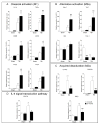
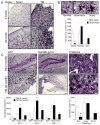

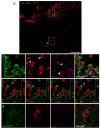


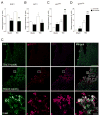
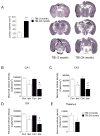
Similar articles
-
NOX2 drives M1-like microglial/macrophage activation and neurodegeneration following experimental traumatic brain injury.Brain Behav Immun. 2016 Nov;58:291-309. doi: 10.1016/j.bbi.2016.07.158. Epub 2016 Jul 28. Brain Behav Immun. 2016. PMID: 27477920 Free PMC article.
-
Administration of DHA Reduces Endoplasmic Reticulum Stress-Associated Inflammation and Alters Microglial or Macrophage Activation in Traumatic Brain Injury.ASN Neuro. 2015 Dec 18;7(6):1759091415618969. doi: 10.1177/1759091415618969. Print 2015 Nov-Dec. ASN Neuro. 2015. PMID: 26685193 Free PMC article.
-
Microglia/macrophage polarization dynamics in white matter after traumatic brain injury.J Cereb Blood Flow Metab. 2013 Dec;33(12):1864-74. doi: 10.1038/jcbfm.2013.146. Epub 2013 Aug 14. J Cereb Blood Flow Metab. 2013. PMID: 23942366 Free PMC article.
-
Microglial activation as a compelling target for treating acute traumatic brain injury.Curr Med Chem. 2015;22(6):759-70. doi: 10.2174/0929867321666141106124657. Curr Med Chem. 2015. PMID: 25386818 Review.
-
Microglia in the TBI brain: The good, the bad, and the dysregulated.Exp Neurol. 2016 Jan;275 Pt 3(0 3):316-327. doi: 10.1016/j.expneurol.2015.08.018. Epub 2015 Sep 3. Exp Neurol. 2016. PMID: 26342753 Free PMC article. Review.
Cited by
-
Diverse changes in microglia morphology and axonal pathology during the course of 1 year after mild traumatic brain injury in pigs.Brain Pathol. 2021 Sep;31(5):e12953. doi: 10.1111/bpa.12953. Epub 2021 May 7. Brain Pathol. 2021. PMID: 33960556 Free PMC article.
-
Age increases reactive oxygen species production in macrophages and potentiates oxidative damage after spinal cord injury.Neurobiol Aging. 2016 Nov;47:157-167. doi: 10.1016/j.neurobiolaging.2016.07.029. Epub 2016 Aug 6. Neurobiol Aging. 2016. PMID: 27596335 Free PMC article.
-
Cellular and temporal expression of NADPH oxidase (NOX) isotypes after brain injury.J Neuroinflammation. 2013 Dec 17;10:155. doi: 10.1186/1742-2094-10-155. J Neuroinflammation. 2013. PMID: 24344836 Free PMC article.
-
Current understanding of neuroinflammation after traumatic brain injury and cell-based therapeutic opportunities.Chin J Traumatol. 2018 Jun;21(3):137-151. doi: 10.1016/j.cjtee.2018.02.003. Epub 2018 Apr 24. Chin J Traumatol. 2018. PMID: 29764704 Free PMC article. Review.
-
Mechanisms and potential therapeutic applications of microglial activation after brain injury.CNS Neurosci Ther. 2015 Apr;21(4):309-19. doi: 10.1111/cns.12360. Epub 2014 Dec 4. CNS Neurosci Ther. 2015. PMID: 25475659 Free PMC article. Review.
References
-
- Ansari MA, Roberts KN, Scheff SW. A time course of contusion-induced oxidative stress and synaptic proteins in cortex in a rat model of TBI. Journal of neurotrauma. 2008b;25:513–26. - PubMed
-
- Badan I, Buchhold B, Hamm A, Gratz M, Walker LC, Platt D, Kessler C, Popa-Wagner A. Accelerated glial reactivity to stroke in aged rats correlates with reduced functional recovery. J Cereb Blood Flow Metab. 2003;23:845–54. - PubMed
-
- Block ML, Hong JS. Microglia and inflammation-mediated neurodegeneration: multiple triggers with a common mechanism. Prog Neurobiol. 2005;76:77–98. - PubMed
Publication types
MeSH terms
Grants and funding
LinkOut - more resources
Full Text Sources
Other Literature Sources
Miscellaneous

